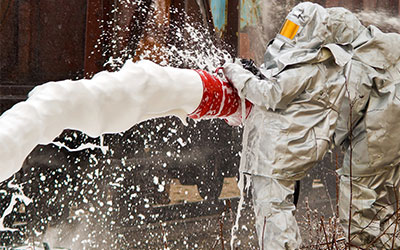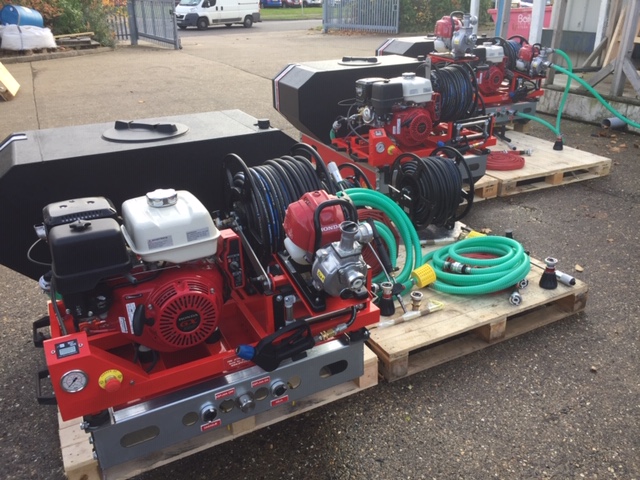FOAMS
We propose a wide range of foams ensuring that the user has the best solution for his risk.
The 3F basics
The answer to replace these chemical components lies in the combination of surfactants and polymers on a natural basis and the synergistic combination of their properties allowing a complete range of foams to be used.

We propose a wide range of foams ensuring that the user has the best solution for his risk.

We provide equipment to apply foam onto the fire in the safest, most efficient and economical manner.
DOSING SYSTEM
Electronic Dosing Systems Mechanical Dosing SystemsOther equipment
Fire Disaster Prevention
An environmentally friendly complete solution that, beyond overall performance and efficiency, will eliminate the environmental damage caused by foams.
Our environmental charter
Environment
3F is committed to the path of fluorine-free products with its class A additives and class B multi-purpose foams. 3F innovates and launches its SMART FOAM -SF range of solvent-free foams as a preview on the market.
Discover the SMART FOAM rangeA global network
3F is a company run by experienced people who have demonstrated their knowledge in firefighting over the last thirty years. With offices in England, Singapore and Panama, our company is able to respond quickly and efficiently to the demands of our customers all over the world.
Togo
3FFF Ltd
Thierry Bluteau
export@3fff.co.uk
+33 761 461 665
Benin
3FFF Ltd
Thierry Bluteau
export@3fff.co.uk
+33 761 461 665
Niger
3FFF Ltd
Thierry Bluteau
export@3fff.co.uk
+33 761 461 665
Mauritania
3FFF Ltd
Thierry Bluteau
export@3fff.co.uk
+33 761 461 665
Mali
3FFF Ltd
Thierry Bluteau
export@3fff.co.uk
+33 761 461 665
Burkina Faso
3FFF Ltd
Thierry Bluteau
export@3fff.co.uk
+33 761 461 665
Madagascar
3FFF Ltd
Thierry Bluteau
export@3fff.co.uk
+33 761 461 665
Angola
3FFF Ltd
Thierry Bluteau
export@3fff.co.uk
+33 761 461 665
New Caledonia
3FFF Ltd
Thierry Bluteau
export@3fff.co.uk
+33 761 461 665
Luxembourg
3FFF Ltd
Thierry Bluteau
export@3fff.co.uk
+33 761 461 665
Belgium
3FFF Ltd
Thierry Bluteau
export@3fff.co.uk
+33 761 461 665
Croatia
3FFF Ltd
Gary McDowall
sales@3fff.co.uk
+44 1536 202 919 / +44 7801 850 011
Hungary
3FFF Ltd
Gary McDowall
sales@3fff.co.uk
+44 1536 202 919 / +44 7801 850 011
Romania
3FFF Ltd
Gary McDowall
sales@3fff.co.uk
+44 1536 202 919 / +44 7801 850 011
New Zealand
3FFF Ltd
Gary McDowall
sales@3fff.co.uk
+44 1536 202 919 / +44 7801 850 011
Salvador
3F AMERICAS Inc.
Xiomara Escalante
ventas@3famericas.com
+507 6494 5421
Belize
3F AMERICAS Inc.
Xiomara Escalante
ventas@3famericas.com
+507 6494 5421
Canada
3F AMERICAS Inc.
Thierry Bluteau
export@3famericas.com
+33 761 461 665
United Arab Emirates
3FFF Ltd
Gary McDowall
sales@3fff.co.uk
+44 1536 202 919 / +44 7801 850 011
Cuba
3F AMERICAS Inc.
Xiomara Escalante
ventas@3famericas.com
+507 6494 5421
Honduras
3F AMERICAS Inc.
Xiomara Escalante
ventas@3famericas.com
+507 6494 5421
Nicaragua
3F AMERICAS Inc.
Xiomara Escalante
ventas@3famericas.com
+507 6494 5421
Dominican Republic
3F AMERICAS Inc.
Xiomara Escalante
ventas@3famericas.com
+507 6494 5421
Costa Rica
3F AMERICAS Inc.
Xiomara Escalante
ventas@3famericas.com
+507 6494 5421
Guatemala
3F AMERICAS Inc.
Xiomara Escalante
ventas@3famericas.com
+507 6494 5421
Mexico
3F AMERICAS Inc.
Armando Merino
amerino@3famericas.com
+52 442 336 0675
Bolivia
3F AMERICAS Inc.
Pablo Rojas
projas@3famericas.com
+593 99 99 600 92
Colombia
3F AMERICAS Inc.
Pablo Rojas
projas@3famericas.com
+593 99 99 600 92
Peru
3F AMERICAS Inc.
Pablo Rojas
projas@3famericas.com
+593 99 99 600 92
Ecuador
3F AMERICAS Inc.
Pablo Rojas
projas@3famericas.com
+593 99 99 600 92
Chile
3F AMERICAS Inc.
Pablo Rojas
projas@3famericas.com
+593 99 99 600 92
Panama
3F AMERICAS Inc.
Thierry Bluteau
export@3famericas.com
+33 761 461 665
Argentina
Melisam Fire Group
Melisam Fire Group
info@melisam.com
5411 4766-6100
Uruguay
3F AMERICAS Inc.
Thierry Bluteau
export@3famericas.com
+33 761 461 665
Venezuela
3F AMERICAS Inc.
Thierry Bluteau
export@3famericas.com
+33 761 461 665
Brazil
3F AMERICAS Inc.
Thierry Bluteau
export@3famericas.com
+33 761 461 665
Australia
3FFF Ltd
Gary McDowall
sales@3fff.co.uk
+44 1536 202 919 / +44 7801 850 011
Oman
3FFF Ltd
Gary McDowall
sales@3fff.co.uk
+44 1536 202 919 / +44 7801 850 011
Iraq
3FFF Ltd
Gary McDowall
sales@3fff.co.uk
+44 1536 202 919 / +44 7801 850 011
India
3FFF Ltd
Gary McDowall
sales@3fff.co.uk
+44 1536 202 919 / +44 7801 850 011
China
3FFF Ltd
Gary McDowall
sales@3fff.co.uk
+44 1536 202 919 / +44 7801 850 011
Pakistan
3FFF Ltd
Gary McDowall
sales@3fff.co.uk
+44 1536 202 919 / +44 7801 850 011
South Korea
3F ASIA
Kenneth Loh
kenneth@3fffasia.com
+65 9738 3218
Japan
3F ASIA
Kenneth Loh
kenneth@3fffasia.com
+65 9738 3218
Brunei
3F ASIA
Kenneth Loh
kenneth@3fffasia.com
+65 9738 3218
Laos
3FFF Ltd
Thierry Bluteau
export@3fff.co.uk
+33 761 461 665
Cambodia
3FFF Ltd
Thierry Bluteau
export@3fff.co.uk
+33 761 461 665
Taiwan
3F ASIA
Kenneth Loh
kenneth@3fffasia.com
+65 9738 3218
Philippines
3F ASIA
Kenneth Loh
kenneth@3fffasia.com
+65 9738 3218
Thailand
3F ASIA
Kenneth Loh
kenneth@3fffasia.com
+65 9738 3218
Vietnam
3F ASIA
Kenneth Loh
kenneth@3fffasia.com
+65 9738 3218
Indonesia
3F ASIA
Kenneth Loh
kenneth@3fffasia.com
+65 9738 3218
Malaysia
3F ASIA
Kenneth Loh
kenneth@3fffasia.com
+65 9738 3218
Singapore
3F ASIA
Kenneth Loh
kenneth@3fffasia.com
+65 9738 3218
Sudan
3FFF Ltd
Gary McDowall
sales@3fff.co.uk
+44 1536 202 919 / +44 7801 850 011
Egypt
3FFF Ltd
Gary McDowall
sales@3fff.co.uk
+44 1536 202 919 / +44 7801 850 011
Kenya
3FFF Ltd
Gary McDowall
sales@3fff.co.uk
+44 1536 202 919 / +44 7801 850 011
South Africa
3FFF Ltd
Gary McDowall
sales@3fff.co.uk
+44 1536 202 919 / +44 7801 850 011
Mauritius
3FFF Ltd
Thierry Bluteau
export@3fff.co.uk
+33 761 461 665
Congo BZ
3FFF Ltd
Thierry Bluteau
export@3fff.co.uk
+33 761 461 665
Gabon
3FFF Ltd
Thierry Bluteau
export@3fff.co.uk
+33 761 461 665
Ghana
3FFF Ltd
Thierry Bluteau
export@3fff.co.uk
+33 761 461 665
Cameroun
3FFF Ltd
Thierry Bluteau
export@3fff.co.uk
+33 761 461 665
Ivory Coast
3FFF Ltd
Thierry Bluteau
export@3fff.co.uk
+33 761 461 665
Senegal
3FFF Ltd
Thierry Bluteau
export@3fff.co.uk
+33 761 461 665
Libya
3FFF Ltd
Thierry Bluteau
export@3fff.co.uk
+33 761 461 665
Tunisia
3FFF Ltd
Thierry Bluteau
export@3fff.co.uk
+33 761 461 665
Algeria
3FFF Ltd
Thierry Bluteau
export@3fff.co.uk
+33 761 461 665
Morocco
3FFF Ltd
Thierry Bluteau
export@3fff.co.uk
+33 761 461 665
Italy
3FFF Ltd
Thierry Bluteau
export@3fff.co.uk
+33 761 461 665
Switzerland
3FFF Ltd
Thierry Bluteau
export@3fff.co.uk
+33 761 461 665
Portugal
3FFF Ltd
Thierry Bluteau
export@3fff.co.uk
+33 761 461 665
Spain
3FFF Ltd
Thierry Bluteau
export@3fff.co.uk
+33 761 461 665
France
3FFF Ltd
Thierry Bluteau
export@3fff.co.uk
+33 761 461 665
Malta
3FFF Ltd
Gary McDowall
sales@3fff.co.uk
+44 1536 202 919 / +44 7801 850 011
Cyprus
3FFF Ltd
Gary McDowall
sales@3fff.co.uk
+44 1536 202 919 / +44 7801 850 011
Turkey
3FFF Ltd
Gary McDowall
sales@3fff.co.uk
+44 1536 202 919 / +44 7801 850 011
Greece
3FFF Ltd
Gary McDowall
sales@3fff.co.uk
+44 1536 202 919 / +44 7801 850 011
Netherlands
3FFF Ltd
Gary McDowall
sales@3fff.co.uk
+44 1536 202 919 / +44 7801 850 011
Austria
3FFF Ltd
Gary McDowall
sales@3fff.co.uk
+44 1536 202 919 / +44 7801 850 011
Germany
3FFF Ltd
Gary McDowall
sales@3fff.co.uk
+44 1536 202 919 / +44 7801 850 011
Poland
3FFF Ltd
Gary McDowall
sales@3fff.co.uk
+44 1536 202 919 / +44 7801 850 011
Lithuania
3FFF Ltd
Gary McDowall
sales@3fff.co.uk
+44 1536 202 919 / +44 7801 850 011
Latvia
3FFF Ltd
Gary McDowall
sales@3fff.co.uk
+44 1536 202 919 / +44 7801 850 011
Estonia
3FFF Ltd
Gary McDowall
sales@3fff.co.uk
+44 1536 202 919 / +44 7801 850 011
Finland
3FFF Ltd
Gary McDowall
sales@3fff.co.uk
+44 1536 202 919 / +44 7801 850 011
Sweden
3FFF Ltd
Gary McDowall
sales@3fff.co.uk
+44 1536 202 919 / +44 7801 850 011
Norway
3FFF Ltd
Gary McDowall
sales@3fff.co.uk
+44 1536 202 919 / +44 7801 850 011
Denmark
3FFF Ltd
Gary McDowall
sales@3fff.co.uk
+44 1536 202 919 / +44 7801 850 011
Ireland
ABC McIntosh Ltd
Becky McDowall
becky@abcmacintosh.com
+44 1536 260 333
United Kingdom
ABC McIntosh Ltd
Becky McDowall
becky@abcmacintosh.com
+44 1536 260 333
SHG is pleased to introduce the ALPSEEsubmersible pump as the latest member of our pump family. ALPSEE complies with DIN 14425 and convinces in particular with an integrated flat suction device, which enables automatic low-level pumping down to a few millimeters’ depth without the use of additional accessories. For optimal and smooth use of the pump, accessory packages with non-return flap and 3 m or 5 m PVC spiral hose are also available. ALPSEE is compact and economic. Find more in our tech sheet.
Electric cars are becoming ever more present on our roads. They present ecological advantages but represent a new challenge for firefighters. Lithium batteries can burn and react to water and foam and release toxic and flammable gases at high temperature. Powder is not efficient either.
To address this peculiar risk, 3F offers a range of special blanket TEXCAR, available in 4 sizes. TEXCAR resists to high temperature but avoids the concentration of gases and eliminates the risk of explosion.
Know more…
FREEGEN ULTRA achieves approval to the new version of VdS 3124:2025-01 for extinction in sprinkler systems. This was achieved together with pour distributor TSF Germany.
Our product passed successfully all fire tests on a large list of solvents and hydrocarbons at a concentration of use at 3%. The list includes the most difficult fuel : aldehyde, which was extinguished at an application rate of 25 l/sqm.mn
On top of that, FREEGEN ULTRA used at 1% was approved on fires of plastics.
The tests demonstrate the efficiency of FREEGEN ULTRA in the most difficult application.